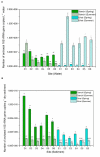Temporal and Spatial Dynamics of Archaeal Communities in Two Freshwater Lakes at Different Trophic Status
- PMID: 27065997
- PMCID: PMC4814500
- DOI: 10.3389/fmicb.2016.00451
Temporal and Spatial Dynamics of Archaeal Communities in Two Freshwater Lakes at Different Trophic Status
Abstract
In either eutrophic Dianchi Lake or mesotrophic Erhai Lake, the abundance, diversity, and structure of archaeaplankton communities in spring were different from those in summer. In summer, archaeaplankton abundance generally decreased in Dianchi Lake but increased in Erhai Lake, while archaeaplankton diversity increased in both lakes. These two lakes had distinct archaeaplankton community structure. Archaeaplankton abundance was influenced by organic content, while trophic status determined archaeaplankton diversity and structure. Moreover, in summer, lake sediment archaeal abundance considerably decreased. Sediment archaeal abundance showed a remarkable spatial change in spring but only a slight one in summer. The evident spatial change of sediment archaeal diversity occurred in both seasons. In Dianchi Lake, sediment archaeal community structure in summer was remarkably different from that in spring. Compared to Erhai Lake, Dianchi Lake had relatively high sediment archaeal abundance but low diversity. These two lakes differed remarkably in sediment archaeal community structure. Trophic status determined sediment archaeal abundance, diversity and structure. Archaeal diversity in sediment was much higher than that in water. Water and sediment habitats differed greatly in archaeal community structure. Euryarchaeota predominated in water column, but showed much lower proportion in sediment. Bathyarchaeota was an important component of sediment archaeal community.
Keywords: Bathyarchaeota; Euryarchaeota; freshwater lake; microbial community; planktonic; sediment; trophic status.
Figures







Similar articles
-
Spatiotemporal variation of planktonic and sediment bacterial assemblages in two plateau freshwater lakes at different trophic status.Appl Microbiol Biotechnol. 2016 May;100(9):4161-75. doi: 10.1007/s00253-015-7253-2. Epub 2015 Dec 28. Appl Microbiol Biotechnol. 2016. PMID: 26711281
-
Temporal and Spatial Dynamics of Sediment Anaerobic Ammonium Oxidation (Anammox) Bacteria in Freshwater Lakes.Microb Ecol. 2017 Feb;73(2):285-295. doi: 10.1007/s00248-016-0872-z. Epub 2016 Oct 10. Microb Ecol. 2017. PMID: 27726034
-
Sediment Ammonia-Oxidizing Microorganisms in Two Plateau Freshwater Lakes at Different Trophic States.Microb Ecol. 2016 Feb;71(2):257-65. doi: 10.1007/s00248-015-0642-3. Epub 2015 Jun 26. Microb Ecol. 2016. PMID: 26111964
-
Ammonia-oxidizing archaea and bacteria in water columns and sediments of a highly eutrophic plateau freshwater lake.Environ Sci Pollut Res Int. 2016 Aug;23(15):15358-69. doi: 10.1007/s11356-016-6707-0. Epub 2016 Apr 25. Environ Sci Pollut Res Int. 2016. PMID: 27109114
-
Photoautotrophic picoplankton - a review on their occurrence, role and diversity in Lake Balaton.Biol Futur. 2020 Dec;71(4):371-382. doi: 10.1007/s42977-020-00030-8. Epub 2020 Jul 31. Biol Futur. 2020. PMID: 34554456 Review.
Cited by
-
Abundance and Co-Distribution of Widespread Marine Archaeal Lineages in Surface Sediments of Freshwater Water Bodies across the Iberian Peninsula.Microb Ecol. 2017 Nov;74(4):776-787. doi: 10.1007/s00248-017-0989-8. Epub 2017 May 16. Microb Ecol. 2017. PMID: 28508926
-
Amsterdam urban canals contain novel niches for methane-cycling microorganisms.Environ Microbiol. 2022 Jan;24(1):82-97. doi: 10.1111/1462-2920.15864. Epub 2021 Dec 13. Environ Microbiol. 2022. PMID: 34863018 Free PMC article.
-
Characterization of the composition, structure, and functional potential of bamboo rhizosphere archaeal communities along a chromium gradient.Front Microbiol. 2024 Apr 17;15:1372403. doi: 10.3389/fmicb.2024.1372403. eCollection 2024. Front Microbiol. 2024. PMID: 38694797 Free PMC article.
-
Influences of plant type on bacterial and archaeal communities in constructed wetland treating polluted river water.Environ Sci Pollut Res Int. 2016 Oct;23(19):19570-9. doi: 10.1007/s11356-016-7166-3. Epub 2016 Jul 8. Environ Sci Pollut Res Int. 2016. PMID: 27392623
-
Comparative evaluation of three archaeal primer pairs for exploring archaeal communities in deep-sea sediments and permafrost soils.Extremophiles. 2019 Nov;23(6):747-757. doi: 10.1007/s00792-019-01128-1. Epub 2019 Sep 5. Extremophiles. 2019. PMID: 31489482
References
-
- Billard E., Domaizon I., Tissot N., Arnaud F., Lyautey E. (2015). Multi-scale phylogenetic heterogeneity of archaea, bacteria, methanogens and methanotrophs in lake sediments. Hydrobiologia 751 159–173. 10.1007/s10750-015-2184-6 - DOI
-
- Borrel G., Lehours A. C., Crouzet O., Jezequel D., Rockne K., Kulczak A., et al. (2012). Stratification of Archaea in the deep sediments of a freshwater meromictic lake: vertical shift from methanogenic to uncultured archaeal lineages. PLoS ONE 7:e43346 10.1371/journal.pone.0043346 - DOI - PMC - PubMed
LinkOut - more resources
Full Text Sources
Other Literature Sources

